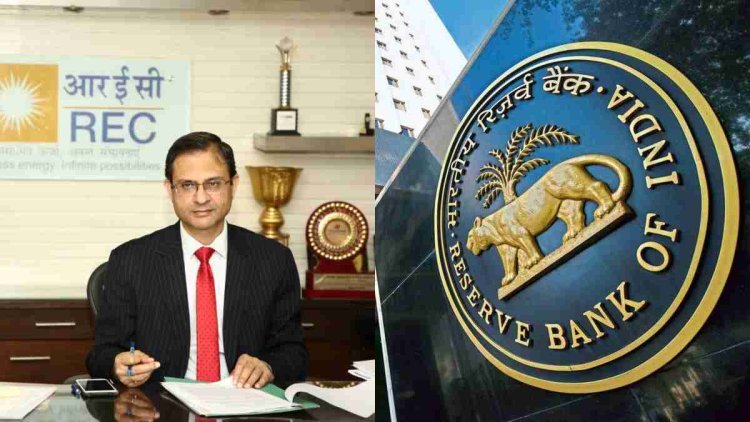Sanjay Malhotra appointed as new RBI Governor
On Monday, Sanjay Malhotra was named the new Governor of the Reserve Bank of India (RBI), putting an end to speculation about an extension for the current governor, Shaktikanta Das.

With a deep understanding of policy, markets, and technology, Sanjay’s experience is unparalleled. He’s had an odyssey through lots of financial institutions. This experience has undoubtedly sharpened his skills, making him the right choice to lead the Reserve Bank of India.
The RBI Governor appointment process also needs a vigorous vetting process, making sure this important role has the right fit. Sanjay’s vision to strengthen the Indian economy holds great promise for a powerful impact during his watch.
It’s his leadership style of transparency and willingness to grow that is meeting the needs of the economy and the residents. Look for the kind of creative thinking we’ve seen from him in the past as he assumes this crucial role.
Who is Sanjay Malhotra?
Early Life and Education
Sanjay Malhotra was born in Bikaner, Rajasthan, a city famous for its beautiful palaces and temples. Having grown up in such an environment, he possessed a profound appreciation for the needs and aspirations of society at large. He started his academic career at the Indian Institute of Technology (IIT) Kanpur.
There, he completed a Bachelor’s degree in Computer Science Engineering. His tough education having given him a sharp analytical mind. It also gave him technical skills, giving him a strong technical foundation for the work he’d do later. Continuing his quest for knowledge, he completed his post-graduation with a Master’s in Public Policy from Princeton University, USA.
This higher level education was a testament to his vision for developing the field of public administration. It also provided him with a priceless global perspective that would greatly enrich his civil service career.
Career Path and Achievements
Sanjay Malhotra’s interesting career started when he got inducted to the Indian Administrative Service (IAS) in 1990, of the Rajasthan cadre. He has more than three decades of experience. His professional path is marked by impactful leadership within the fields of finance, taxation, power, information technology, and mining.
His time as Chairman and Managing Director of REC Ltd. Became particularly known for leading REC’s growth and modernization. His long tenure in high-ranking government positions, particularly as secretary of finance, showcases his deep skill and expertise in shaping tax policy and fiscal management.
His leadership and strategic foresight had made him a respected and revered figure in the bureaucratic community.
Key Roles in Finance Ministry
First as Financial Services Secretary and now as Revenue Secretary, Malhotra has positioned the state to excel at tax collection. He has served as a leading visionary for fiscal discipline. His contributions to pushing through much-needed reforms in the financial sector have been phenomenal.
As ex-officio Secretary to the GST Council, he managed state fiscal expectations with great finesse, all the while preserving the integrity of the GST framework. His dealings with major stakeholders, such as state governments and public sector undertakings, testify to his remarkable ability to navigate complicated financial ecosystems.
Malhotra has also managed to achieve 5.4% growth in the midst of a national recession, a testament to his strong leadership.
Sanjay Malhotra's Qualifications
Sanjay Malhotra’s qualifications make him an excellent candidate for RBI Governor. We believe his solid qualifications, background and experience clearly set him apart from other candidates. His more than 33 years of experience in public finance and economic policy will serve as a rich resource.
As a 1980-batch Indian Administrative Service (IAS) officer, his professional journey has been marked by brilliant contributions to the fiscal development of India. His tenure includes impactful roles in finance, taxation, power, information technology, and mining. Particularly in these areas, his leadership has been essential in guiding fiscal policy, especially through leadership of eight Union Budgets.
Academic Credentials
His engineering background in Computer Science provides a strong analytical foundation. This education equips him with a deep understanding of public policy. These credentials have deeply enriched his expertise in the arena of public policy.
His academic excellence has been rewarded with numerous awards, highlighting his dedication to academic excellence.
Professional Experience
Previously, Malhotra has served in several important roles in Indian Administrative Service including as Chairman and Managing Director of REC Ltd. His background in several ministries, especially finance and economic affairs, shows his experience dealing with complex financial systems.
His role in shaping high-level decision making processes that impact national policy shows his strategic clout. His versatility through various positions demonstrates that he has the ability to oversee various sectors successfully.
Skills Relevant to RBI Role
Sanjay Malhotra has skills that are absolutely critical to the RBI. His expertise in strategic planning and economic analysis will be essential to advancing fiscal policy and tax administration priorities.
These leadership and communication skills, in turn, make him especially well suited to guide the central bank through choppy waters. His ability to operate in dynamic regulatory environments translates into smart program stewardship and oversight.
Appointment as RBI Governor
As the constructor of India’s economic edifice, the role of Reserve Bank of India (RBI) Governor is pivotal. As the chief monetary authority, the Governor determines the direction of monetary policy, inflation levels and overall financial stability. The duties range from the government’s printer of currency, with monopoly power over currency issuance, to foreign exchange management.
Since the RBI Governor’s decisions don’t only affect the domestic market but international investors as well, they play a huge role in steering the economic trajectory of the country.
Selection Process Explanation
|
Step |
Description |
|---|---|
|
Step 1 |
Nomination by the Appointments Committee |
|
Step 2 |
Review of candidates' qualifications |
|
Step 3 |
Final approval by the Prime Minister and Cabinet |
|
Step 4 |
Official announcement of the appointment |
However, the process that resulted in Sanjay Malhotra’s appointment is rigorous and detailed. It starts with a nomination by the Appointments Committee, but then there is a detailed and intensive vetting of the candidate’s qualifications.
Final approval is given by the Prime Minister and Cabinet. Once these paths intersect, the official announcement of the appointment follows.
Criteria for Eligibility
Candidates for the RBI Governor position must meet several key criteria:
-
Extensive experience in finance and economics
-
Proven leadership capabilities in public administration
-
Strong understanding of monetary policy and banking systems
-
Educational qualifications relevant to the role
One good example of such appointment is Sanjay Malhotra, 1990 batch Rajasthan cadre IAS Officer. His track record of serving as Secretary (Revenue) in the Ministry of Finance highlights his keen leadership abilities.
Moreover, his prior service within the Department of Financial Services only accentuates his keen expertise. His award as the world’s central banker of the year underscores his deep competence in steering national economies through stormy skies.
Historical Context of Appointments
The RBI Governor’s post has changed drastically over the years. Notable past governors such as Raghuram Rajan and Manmohan Singh have left an indelible mark on India’s economic policies.
His predecessor, Shaktikanta Das, who oversaw the RBI through several crises, including the Covid-19 pandemic and recent geopolitical tensions, is credited with preventing recession. Historical appointment patterns indicate a bias toward those with deep backgrounds in economic and government management.
Sanjay Malhotra assumes this responsibility at one of the most challenging junctures. Here we are with inflation still too high and persistent, above the 4% target, and with growth slowing.
He will have to do so when he steers his first monetary policy review in February 2025 to these pressing matters. Continuity in policy implementation will be key to steering the country through the difficult present and uncertain future economic climate.
Transition from Shaktikanta Das
End of Previous Tenure
Shaktikanta Das has certainly had some huge accomplishments on his watch, as the Governor of the Reserve Bank of India (RBI). His leadership has led to transformative policies that reshaped the institution. During his six-year tenure from Dec 12, 2018 to Dec 10, 2024, Das made global headlines.
He is also known for winning a rare “A+” rating in the Global Finance Central Banker Report Cards for two straight years. His leadership was recently recognized again when he was awarded the title of ‘Governor of the Year 2023’ by Central Banking journal. When the economy experienced volatility, Das was decisive in implementing important policies to stabilize the economy.
He made aggressive monetary policy changes, while cultivating a new interest in financial stability. Real problems have arisen, such as high CPI inflation. Yet, let’s not forget that static interest rates since February 2023 have further contributed to the complexity.
Sanjay Malhotra will need to steer this important transition period. He will assume office on December 11, 2024, and it’s critical for him to keep market confidence intact through this leadership transition.
Transition Challenges
Sanjay Malhotra will have his hands full with a lot of other challenges as he takes over the RBI Governor baton. However, the current economic challenges, including persistently high CPI inflation, demand a more urgent response.
What’s more, public expectations are soaring, considering the successful tenure of his predecessor. It will be Malhotra’s power to convene diverse stakeholders productively that will be most critical to guiding the fast-changing economic environment.
Most importantly, he’ll need to adapt to the challenges of our times. At the same time, he’ll have to look down the road to future changes in the economy.
Opportunities for Change
Taking over the reins, Malhotra has a remarkable opportunity to steer the central bank in a new direction and push reforms agenda within the RBI. Areas such as digital banking and financial inclusion offer opportunities for well-timed action with real impact.
Sustained innovation in our monetary policy could help create a more resilient economic framework that makes policy more effective. Being willing to tackle today’s economic challenges with new approaches will be key to Malhotra’s success.
Sanjay Malhotra's Vision for RBI
Sanjay Malhotra’s vision for a new Reserve Bank of India (RBI) begins with economic stability. He is committed to promoting inclusive growth and sustainable development. Malhotra has more than three decades experience in fiscal, taxation, and energy sectors. He wants to use his experience to strengthen faith in monetary policy and achieve long-term sustainable growth.
His short-term priorities are to ensure monetary policy is aligned with expected fiscal stimulus to grow the economy without fuelling inflation. India's economy, currently grappling with a 6.5% inflation rate and slowing growth, presents a critical juncture for Malhotra's leadership, which begins on December 11, 2024, for a three-year term.
1. Economic Stability Goals
Malhotra’s economic stability goals prioritize keeping inflation and interest rates in check to create a stable macroeconomic environment. Through shrewd monetary policy, namely recalibrating interest rates, he hopes to tackle rampant inflation and make the country a magnet for investment.
His approach makes clear the RBI’s essential role still is in restoring confidence in the financial system. This is doubly important given the economic crisis we are all navigating. As India navigates rising inflation, his leadership is expected to reinforce the trust in monetary policies, ensuring they support sustainable economic growth.
2. Financial Inclusion Strategies
Malhotra envisions enhancing financial inclusion through several strategies:
-
Expanding access to banking services in rural areas
-
Implementing technology-driven solutions for underserved populations
-
Collaborating with fintech companies to enhance service delivery
-
Promoting financial literacy initiatives among citizens
These initiatives help bridge the divide in access to financial services. Their work guarantees that all Americans have access to basic banking services, regardless of their geographic location.
Malhotra is proactive in forging alliances with fintech companies. His vision is to use technology to enhance the accessibility and inclusiveness of the financial services ecosystem to the underbanked and unbanked populations.
3. Technological Advancements in Banking
For technological adoption, embrace is key under Malhotra’s stewardship. Next potential innovations like digital currencies and blockchain technology could transform banking by increasing efficiency and transparency.
Malhotra warns that as we move into this new digital era with cashless transactions, RBI must have strong cybersecurity protections to safeguard financial data. Together, these technologies radically modernize the infrastructure of banking operations.
They also fortify the financial sector’s security and resiliency against new and evolving threats.
4. Regulatory Improvements
Looking ahead, Malhotra sees room for regulatory improvement under the RBI umbrella. Reducing bureaucratic burdens to enable faster operations and embracing adaptive regulation will be key to staying ahead of market evolution.
This new reality makes the RBI’s role in ensuring a strong regulatory environment even more essential in a time of quickly-changing financial products and platforms. Malhotra’s appointment is a strong signal that the government has confidence in his abilities.
He will work collaboratively with them and foster a regulatory framework that encourages innovation and growth.
Potential Impact on RBI
Short-term Effects
Sanjay Malhotra is the new RBI Governor. His leadership is sure to ignite short-term changes to the central bank’s landscape. With his extensive experience in key financial sectors, Malhotra is well-equipped to tackle pressing issues such as inflation management and stable economic growth amid global uncertainties.
One of the expected immediate effects might be changes to the current monetary policy, especially related to interest rates. The RBI has consistently held interest rates high for nearly two years due to the risk of inflation. With Malhotra at the helm, increasing calls to accelerate economic growth could push them to take a more hawkish turn.
We cannot afford to ignore these short-term economic challenges. With economic growth slowing to a 5.4% annual rate for the July-September period, there is no time to waste. As this transition unfolds, the RBI’s role in standing ready to respond to market changes and supporting broader economic stability will be more important than ever.
Long-term Implications
Long term, however, Malhotra’s direction could reshape the RBI’s approach to monetary policy and economic growth strategy. His past success in driving strong, sustainable tax collections reflects his value for this kind of growth. This emphasis on fiscal health lays the groundwork for long-term financial resilience.
As the new RBI Governor, Malhotra will be committed to guiding India’s economic future in the right direction. Looking ahead, he intends to focus on long-term strategic planning and fiscal discipline. The potential shifts in policy might also align with broader goals of sustainable growth, ensuring financial resilience in a complex global landscape.
His experience in the finance ministry is deep. As Secretary in the newly created Department of Financial Services, he’ll be an instrumental force in orienting the RBI towards its broader goals.
Industry Expert Opinions
The reaction from industry experts runs the gamut of disappointment to cautious optimism on Malhotra’s appointment. Most are looking on his qualifications and deep experience as huge assets that will be an immense boon to the RBI.
Yet others are more circumspect about the challenges that await. Many experts also predict a huge change in the RBI’s focus under his stewardship. In doing so, they highlight the critical role of transparent and consistent messaging with market participants to maintain confidence and stability.
These very expert opinions are also crucial in understanding what potential economic policies could mean and their overall impact on India’s financial landscape. Both illustrate the complex challenges and opportunities that Malhotra will likely encounter. This deep dive provides an in-depth look at the RBI’s potential impact and future trajectory.
Conclusion
Sanjay Malhotra walks into the role with an enviable background and a strong point of view. He comes with a good track-record and an outsider’s fresh perspective to the Reserve Bank of India. His leadership guarantees a commitment to both stability and growth, and will combine to help the bank navigate any headwinds or tailwinds that economic conditions may present. Malhotra’s vision resonates with India’s emerging economic ecosystem, placing the RBI at the forefront of financial regulatory leadership. As he steps into the role from Shaktikanta Das, the changeover also marks a beginning of a new chapter for the RBI. So watch closely how his strategies play out, and what they mean for India’s financial future. Don’t miss these changes, which may affect the policies of our nation’s economic stewards and your personal economic landscape.
Frequently Asked Questions
Who is Sanjay Malhotra?
Sanjay Malhotra is one of India’s leading economic and financial policy experts. Renowned for his sharp acumen over monetary policies, Raghuram Rajan has served in many top offices of India’s financial space.
What are Sanjay Malhotra's qualifications?
Sanjay Malhotra has a Master’s degree in Economics from the Delhi School of Economics, University of Delhi. He has more than 25 years of experience in banking and financial management.
How did Sanjay Malhotra become the RBI Governor?
Sanjay Malhotra was appointed as the RBI Governor after a Cabinet decision. His appointment was fortuitous and inspired— based on his experience and out-of-the-box thinking to tackle India’s economic challenges.
What changes to expect with Sanjay Malhotra's appointment as RBI Governor?
Under Sanjay Malhotra, look for a smart, strategic approach that emphasizes sustainable economic growth, digital banking and financial inclusion. His policies — or rather his government’s policies — seek to reinforce India’s financial underpinnings.
How does Sanjay Malhotra's vision impact the RBI?
Underlying Malhotra’s vision is a commitment to both foster innovation and ensure stability. He wants to make banking infrastructure more efficient, boost cybersecurity, and bring financial literacy to everyone in India.
What was the transition like from Shaktikanta Das to Sanjay Malhotra?
The transition was seamless, with a very clear delegation of authority and responsibility. While Malhotra expands on Das’s policies, he brings in new strategies specifically aimed at today’s economic realities.
What potential impact could Sanjay Malhotra have on the RBI?
Malhotra’s leadership promise a strong new economic governance initiative, world-class technology for banking, and enhanced global competitiveness for India’s financial sector.
What's Your Reaction?















